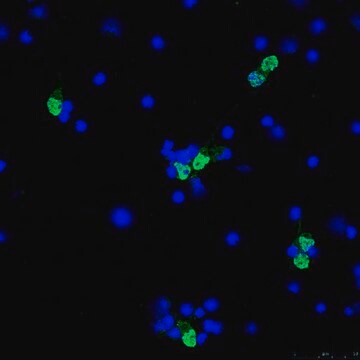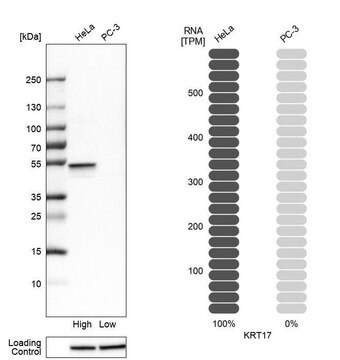おすすめの製品
由来生物
rabbit
品質水準
結合体
unconjugated
抗体製品の状態
affinity isolated antibody
抗体製品タイプ
primary antibodies
クローン
polyclonal
形状
buffered aqueous solution
分子量
antigen 49 kDa
化学種の反応性
mouse, rat, human
濃度
~1 mg/mL
テクニック
ELISA: 1:20000
immunohistochemistry: 1:50-1:100
western blot: 1:500-1:1000
NCBIアクセッション番号
UniProtアクセッション番号
輸送温度
wet ice
保管温度
−20°C
ターゲットの翻訳後修飾
unmodified
遺伝子情報
human ... KRT15(3866)
詳細
Anti-Keratin 15 Antibody detects endogenous levels of total Keratin 15 protein.
Keratin 15 (KRT15)/cytokeratin 15, a type I keratin, belongs to the keratin (KRT) gene family. It is expressed in basal keratinocytes of stratified epithelium. KRT15 gene is located on human chromosome 17q21.2. Anti-Keratin 15 antibody detects endogenous levels of total Keratin 15 protein.
免疫原
The antiserum was produced against synthesized peptide derived from human Keratin 15.
Immunogen Range: 1-50
Immunogen Range: 1-50
アプリケーション
Anti-Keratin 15 antibody produced in rabbit has been used in: immunohistochemistry (1:100), immunofluorescence (1:100), immunostaining
生物化学的/生理学的作用
Keratin 15 (KRT15) participates in maintaining cytoplasmic stability. It acts as a marker for skin stem cells in the hair follicle bulge. KRT15 plays a major role in epidermal homeostasis. It is associated with tumorigenesis. KRT15 might serve as a biomarker in predicting the prognosis of breast invasive carcinoma (BRCA) patients. Overexpression of the KRT15 gene is seen in squamous-cell carcinoma.
特徴および利点
Evaluate our antibodies with complete peace of mind. If the antibody does not perform in your application, we will issue a full credit or replacement antibody. Learn more.
物理的形状
ウサギIgGのPBS溶液(Mg2+およびCa2+を含まず)、pH 7.4、150 mM NaCl、0.02% アジ化ナトリウム、50% グリセロール
免責事項
Unless otherwise stated in our catalog or other company documentation accompanying the product(s), our products are intended for research use only and are not to be used for any other purpose, which includes but is not limited to, unauthorized commercial uses, in vitro diagnostic uses, ex vivo or in vivo therapeutic uses or any type of consumption or application to humans or animals.
適切な製品が見つかりませんか。
製品選択ツール.をお試しください
保管分類コード
10 - Combustible liquids
WGK
nwg
引火点(°F)
Not applicable
引火点(℃)
Not applicable
試験成績書(COA)
製品のロット番号・バッチ番号を入力して、試験成績書(COA) を検索できます。ロット番号・バッチ番号は、製品ラベルに「Lot」または「Batch」に続いて記載されています。
Development of the human prostate
Cunha GR, et al.
Differentiation, 103, 24-45 (2018)
X Rao et al.
Neoplasma, 67(2), 410-414 (2019-12-31)
Keratin-15 (KRT15) is a type I keratin lacking a defined type II partner and plays a key role in maintaining cytoplasmic stability. Recently, studies have reported that KRT15 was correlated with tumor formation and progression. However, the clinical significance of
Pengcheng Zhong et al.
Experimental and therapeutic medicine, 21(4), 305-305 (2021-03-16)
Although keratin 15 (KRT15) has been indicated to be overexpressed in several types of tumor, its role in breast invasive carcinoma (BRCA) has so far remained elusive. The aim of the present study was to explore KRT15 expression in BRCA
Gerald R Cunha et al.
Differentiation; research in biological diversity, 103, 24-45 (2018-09-19)
This paper provides a detailed compilation of human prostatic development that includes human fetal prostatic gross anatomy, histology, and ontogeny of selected epithelial and mesenchymal differentiation markers and signaling molecules throughout the stages of human prostatic development: (a) pre-bud urogenital
Gerald R Cunha et al.
Differentiation; research in biological diversity, 115, 37-52 (2020-08-30)
The goal of this paper is to explore the ability of the human female urogenital sinus immediately below the bladder (proximal urethra) to undergo prostatic development in response to dihydrotestosterone (DHT). To establish this idea, xenografts of human fetal female
ライフサイエンス、有機合成、材料科学、クロマトグラフィー、分析など、あらゆる分野の研究に経験のあるメンバーがおります。.
製品に関するお問い合わせはこちら(テクニカルサービス)








